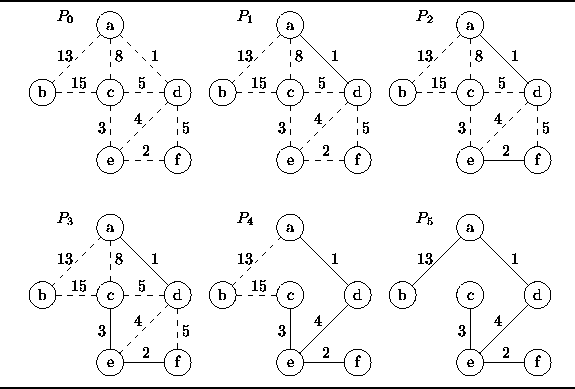|
Data Structures and Algorithms
with Object-Oriented Design Patterns in C# |
Like Prim's algorithm, Kruskal's algorithm also constructs the minimum spanning tree of a graph by adding edges to the spanning tree one-by-one. At all points during its execution the set of edges selected by Prim's algorithm forms exactly one tree. On the other hand, the set of edges selected by Kruskal's algorithm forms a forest of trees.
Kruskal's algorithm is conceptually quite simple. The edges are selected and added to the spanning tree in increasing order of their weights. An edge is added to the tree only if it does not create a cycle.
The beauty of Kruskal's algorithm
is the way that potential cycles are detected.
Consider an undirected graph ![]() .
We can view the set of vertices,
.
We can view the set of vertices, ![]() ,
as a universal set
and the set of edges,
,
as a universal set
and the set of edges, ![]() ,
as the definition of an equivalence relation
over the universe
,
as the definition of an equivalence relation
over the universe ![]() .
(See Definition
.
(See Definition ![]() ).
In general, an equivalence relation partitions
a universal set into a set of equivalence classes.
If the graph is connected,
there is only one equivalence class--all the elements of the universal set are equivalent.
Therefore, a spanning tree is a minimal set of equivalences
that result in a single equivalence class.
).
In general, an equivalence relation partitions
a universal set into a set of equivalence classes.
If the graph is connected,
there is only one equivalence class--all the elements of the universal set are equivalent.
Therefore, a spanning tree is a minimal set of equivalences
that result in a single equivalence class.
Kruskal's algorithm computes,
![]() ,
a sequence of partitions
of the set of vertices
,
a sequence of partitions
of the set of vertices ![]() .
(Partitions are discussed in Section
.
(Partitions are discussed in Section ![]() ).
The initial partition consists of
).
The initial partition consists of ![]() sets of size one:
sets of size one:
![]()
Each subsequent element of the sequence is obtained
from its predecessor by joining two of the elements of the partition.
Therefore, ![]() has the form
has the form
![]()
for ![]() .
.
To construct the sequence
the edges in ![]() are considered one-by-one
in increasing order of their weights.
Suppose we have computed the sequence up to
are considered one-by-one
in increasing order of their weights.
Suppose we have computed the sequence up to ![]() and the next edge to be considered is
and the next edge to be considered is ![]() .
If v and w are both members of the same element of partition
.
If v and w are both members of the same element of partition ![]() ,
then the edge forms a cycle,
and is not part of the minimum-cost spanning tree.
,
then the edge forms a cycle,
and is not part of the minimum-cost spanning tree.
On the other hand, suppose v and w are members of two different
elements of partition ![]() , say
, say ![]() and
and ![]() (respectively).
Then
(respectively).
Then ![]() must be an edge in the minimum-cost spanning tree.
In this case, we compute
must be an edge in the minimum-cost spanning tree.
In this case, we compute ![]() by joining
by joining ![]() and
and ![]() .
That is, we replace
.
That is, we replace ![]() and
and ![]() in
in ![]() by the union
by the union ![]() .
.
Figure ![]() illustrates how Kruskal's algorithm determines
the minimum-cost spanning tree of the graph
illustrates how Kruskal's algorithm determines
the minimum-cost spanning tree of the graph ![]() shown in Figure
shown in Figure ![]() .
The algorithm computes the following sequence of partitions:
.
The algorithm computes the following sequence of partitions:


Figure: Operation of Kruskal's algorithm.